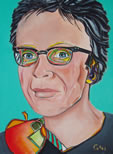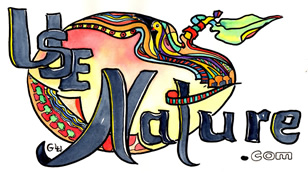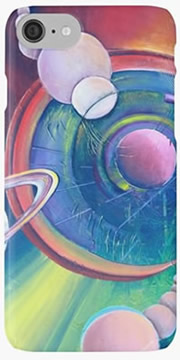useNature.com ... Holistic Therapy and Dermatoglyphics
What is Dermatoglyphics?
Holistic Health - Natural Therapy
useNature's Lifestyle Magazine & Holistic Articles
What is Dermatoglyphics?
Article by Bridgit Lawson ©
... compiled by Dieter L. Editor of useNature
What is Dermatoglyphics?
Dermatoglyphics is the study of the skin ridges or ‘patterns’ on the skin of the hand.
The word comes from ancient Greek - derma = skin, glyph = carving.
The term was first used by Dr Harold Cummins in 1926. He is known as the ‘father of fingerprint analysis.
These skin ridges begin at the fingerprints and also make various patterns throughout the palm. These patterns that the ridges make are unique to each person and do not change throughout a persons’ life. This is in contrast to the larger lines which change according to how a persons’ life develops and the choices they make.
It can also refer to the skin ridges on the soles of the feet and the term is used in the study of genetics.
These ridges serve well to enhance contact as there are multiple nerve endings in the ridges (called Dermal Papillae). The ridges began to form between the 3rd and 4th month of the developing foetus. For the serious practitioner of hand analysis a knowledge and keen observation skills of these skin ridges and the patterns they make will add a great deal of depth and ‘completeness’ to a reading, i.e.: analysis. Dermatoglyphics is also useful in prediagnoses in illness, and in-depth palmistry is now considered an interesting aid in medicine. Unusual dermatoglyphic patterns often relate to genetic disorders. It is actually through my nursing studies that I originally became interested in palmistry.
The patterns that the ridges make on the fingertips and palm range from loops, whorls, arches, through to unique shapes, and an example of ‘unique’ will be mentioned later in the article with discussion of Malcolm X’s fingerprints. All these patterns have significance, especially as to where they may be found on the palm.
Following are some examples of the various meanings that the patterns (whorls, loops, arches) will have when they are found on particular fingers or mounts.
A whorl found on the index (Jupiter) finger talks about the determined, focused, goal achiever. A person with this mark will often easily surmount obstacles to their chosen goals.
A loop found on the index finger represents an adaptable, social ‘go with the flow’ person. This person is often creative and flexible.
An arch on the index finger will talk about the ‘reliability’ of the person, as they are often practical and brave. People with this print are often successful through sheer hard work.
Distinctive patterns also appear on the palm and the following are a few examples of the different meanings.
The Loop of Humour is found between the Mercury and Apollo (ring and little) fingers. These are the eternal optimists, the ones it can be wonderful to be around, for their constant smile.
The Loop of Memory lies at the end of the head line. It is also concerned with the 6th sense, and telepathy
Loops and /or whorls found on the Mount of Moon represent the person who has a vivid, inspirational imagination. These marks mean quite strong psychic and artistic gifts. Such people feel the rhythms of nature and life strongly.
There is also a pattern called the tri-radius. This forms where three groups of skin ridges meet and a ‘Y’ shaped intersection appears. In FBI fingerprint terminology, this pattern is called a ‘delta’. The tri-radius is the mark of the apex or ‘top’ of the mounts of Jupiter, Apollo, Saturn and Mercury, and sometimes on Neptune, Venus and Luna.
A good palmist will take special note of where these apices (plural of apex) occur as their location on the palm will give special or individual meaning to the analysis.
The tri-radius apex may be found high, low, on the side of the mount and occasionally it may not appear at all. When looking for the tri-radius on the mount it is useful to also observe the fleshiness of the mount, for although the tri-radius represents the centre, the fleshy part will represent the strength.
An example of how a tri-radius may influence character is noticeable in whether it is ‘high’ or ‘low’ set under a particular finger. Therefore a low set tri-radius under the little or Mercury finger represents the more introspective person who requires some solitude.
A high set tri-radius (only 3-5 ridge lines to the finger flexure line) will talk about the more outgoing person, the extrovert who loves to talk.
The more rare or unusual the fingerprints appear indicate a person of more active individuality and elevated mental activity. The ‘radial’ loop is a ‘minority’ pattern.
Malcolm X had a horizontal radial loop on his right thumb and also his left index finger.
This is a very rare pattern to be found on one finger let alone two. Malcolm X (Little) was a noted leader of the Black Power movement and a voice for the black movement in America.
Fingerprints and the other dermal patterns have a large affect on the interpretation of a persons’ hand, and how this person approaches their life and achieves their aims.
Article by Bridgit Lawson ©
 useNature Editor
useNature Editor
Dieter Lüske
N.D.-D.C.H.-D.M.H.-D.H
Counselling
Astrology iPhone case
Art Designs by Giselle
© 1998 - 2025 useNature.com: Australia - Natural Health and Lifestyle Information Services - Books
Site Map - Terms / Privacy - Free Alpha Music | Photography | Natural Links |

